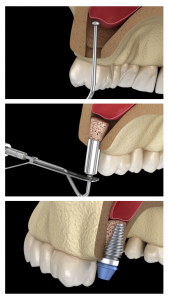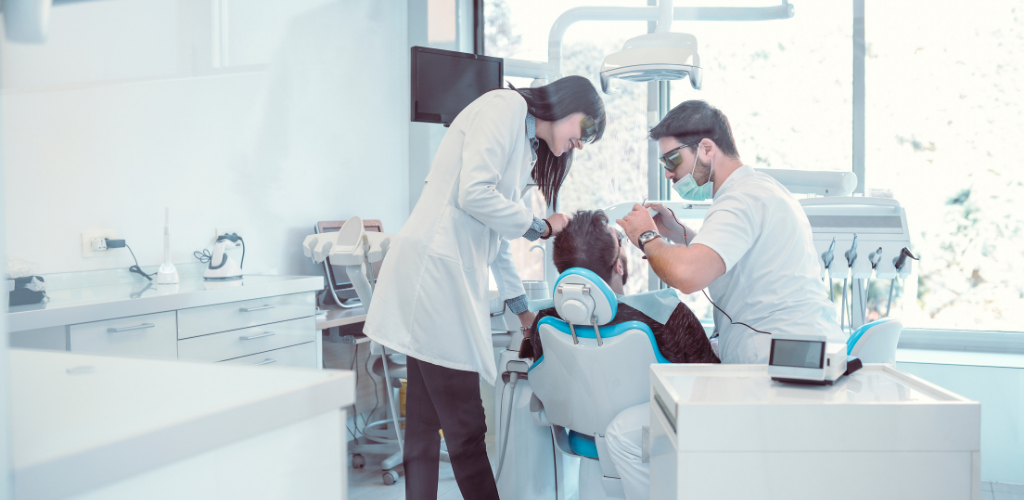Dental implants are becoming a more and more popular option for permanent teeth replacement, making sinus grafts more common as well. Sinus lift surgery may sound scary, but you have nothing to worry about! At Rockcliffe Dental & Denture Centre, a full-service implantology clinic in Ottawa, we conduct sinus lift bone graft procedures for dental implants on a daily basis.
Keep reading to discover answers to any questions you may have about a dental sinus augmentation procedure.
What is a Sinus Lift?
A sinus lift technique, a.k.a. “maxillary sinus floor augmentation,” “maxillary sinus floor elevation,” or simply “sinus augmentation”, is a surgical procedure aimed at increasing the bone volume in the upper jaw or “maxilla”.
Some dental implant candidates don’t have sufficient bone to support the implants, so a bone graft needs to be added to the space between molar teeth and premolars. To make more room for the bone, the sinus membrane is “lifted” upward, which gives the surgery its name.
When Do You Need a Sinus Lift Bone Graft?
In case your sinuses are positioned too close to the upper jaw or you don’t have enough bone height to support dental implants, Dr. Koniouchine may recommend that you get a sinus bone graft.
Some indications for the lift procedure include:
- Long-term tooth loss in the upper jaw, especially back teeth or molars. Anatomically, the posterior maxilla, or the back part of the upper jaw, tends to have less bone than the lower jaw.
- Bone loss due to periodontal disease.
- Reabsorption of bone into the body after tooth extraction. If teeth have been missing for a long time, there is often not enough bone volume left to place implants.
- Natural sinus floor positioned too close to the upper jaw. The size and the shape of the sinus cavity space vary from person to person and can change over time.
What is the Average Cost of a Sinus Lift?
The sinus lift cost can range between $1759 for a simple and small lift to $5000 for more complex cases. The cost of a sinus lift may rise if more bone graft material is needed.
Before, During, and After the Procedure
Before Sinus Lift
If you require a sinus lift oral surgery, your dental professional in Ottawa will first determine which type of bone graft you will get.
The most common types of bone used for sinus augmentation include:
- Allogeneic bone taken from a cadaver.
- Autogenous bone or your own bone – either taken from other areas of your mouth or your body.
- Xenograft or cow bone.
Once the type of bone graft to be used is determined, your oral surgeon will take X-rays to carefully study the shape of your jaw and sinuses and plan out the treatment plan.
Sinus Lift Procedure
At Rockcliffe Dental & Denture Centre, we perform sinus lift procedures in-office. On the day of your appointment, you can expect the following general sequence of steps:
- The surgeon cuts the gum tissue in your upper jaw.
- He then raises the gum tissue, exposing the upper jaw bone underneath.
- The dentist cuts a small circle in the bone.
- He then elevates the bone portion into the maxillary sinus cavity.
- The surgeon fills the hole with a graft material.
- Finally, the surgeon closes the incision.
- The healing begins!
In 4 to 12 months after your surgery, you will be invited back to the office to place dental implants. During this period, the new bone will merge with the existing one; the exact amount of time will depend on how much grafting material you needed.
Sinus Lift Anesthesia
The sinus grafting procedure is performed under local anesthesia, which makes the process virtually painless. However, for those patients with dental anxiety, Rockcliffe Dental & Denture Centre offers various dental sedation options including IV sedation, nitrous oxide or “laughing gas” sedation, and oral sedation.
Sinus Lift Recovery Experience
Most patients who have undergone a sinus lift procedure will take 1 to 2 days off from normal activity and return to work or school once they feel sufficiently recovered. It is also recommended to avoid strenuous activities for 2 weeks after the surgery.
The full recovery from a sinus lift surgery can take 6 months and longer. This time is necessary to allow the sinuses to heal and become strong enough to support dental implants.
Sinus Lift Surgery Aftercare
After your sinus augmentation surgery, it is normal to experience minor discomfort and swelling. You may also experience light bleeding from your mouth or nose in the first days after the surgery.
Shortly after your procedure, avoid sneezing or blowing your nose frequently, as it could cause the stitches to loosen and the bone graft material to move. Please be careful and avoid coming into contact with anything that can make you sneeze.
After the surgery is completed, your implant dentist might give you:
- Pain medication
- A prescription to prevent inflammation and congestion
- Antibiotics
- Saline spray to keep your nose moist
- Antimicrobial mouthwash to help prevent infection
You will be invited to come back to the dental office for a follow-up appointment 7 to 10 days after the surgery. During this appointment, Dr. Koniouchine will examine the surgical site and remove any stitches that have not dissolved.
Sometimes, patients will have to return several more times to make sure that they are healing properly.

Sinus Lift Risks
As with any surgical procedure, there are certain risks associated with sinus augmentation:
- Tearing or puncturing a maxillary sinus membrane. If this happens, the oral surgeon will either place a patch over the sinus tear or stitch it. If the repair of the membrane is complicated, your dentist might recommend waiting for an additional healing period before continuing the procedure.
- Sinus infection. With surgeries, infection is always a possibility. However, infections from a sinus augmentation are uncommon, and your dentist will prescribe you antibiotics after the procedure to minimize the risk.
- Existing bone doesn’t integrate with the additional bone graft. Rarely, the grafted area fails to develop a blood supply. In such a case, you might have to repeat the procedure again.
- Acute maxillary sinusitis. This is a temporary inflammation of the membranes in your sinuses and your nose, which makes it hard to drain mucus from the nose. Caution taken during the procedure can help prevent the condition and keep the sinuses open.
The skills and experience of the dental professional performing the sinus lift surgery play a vital role in the successful outcome, – that is why it is absolutely crucial to choose a trusted dental clinic specializing in dental implants like Rockcliffe Dental & Denture Centre.
Sinus Lift Complications: When to Contact a Professional
Even though the healing process after a sinus augmentation is often smooth and straightforward, you should give us a call immediately if:
- Bleeding continues after 1-2 days or is continuous and bright red
- Pain or swelling increases over time
- You develop a fever
- The bone graft material had dislodged after blowing your nose or sneezing
Sinus Lift Success Rate
Even though complications are possible, receiving a sinus graft is considered to be relatively safe when you are in the hands of a skilled implant dentist in Ottawa. It is a very common dental procedure with a predictable outcome and success rates of over 90%.
Sinus Lift Surgery Alternatives
Some dental clinics are now offering a short or mini-dental implant procedure as an alternative to the sinus lift procedure. A short implant is an implant that is 8mm or less in length, and, as such, it can be placed into areas with less bone, eliminating the need for a bone graft or a sinus elevation procedure.
However, studies have shown that mini dental implants aren’t as strong as standard ones and are associated with much higher failure rates.
At Rockcliffe Dental & Denture Centre, we prioritize the long-term comfort and function for our patients and, as such, prefer to conduct a sinus floor elevation procedure followed by the placement of standard-size dental implants.
Choose Professionals for the Sinus Lift Surgery in Ottawa
While sinus lift surgery is a common dental procedure, it is crucial to choose certified specialists like implant dentists at Rockcliffe Dental & Denture Centre to ensure the best possible outcomes.
Contact us today to learn more about bone graft and dental implant options.
Sinus Augmentation FAQ
The sinus lift surgery itself is conducted under local anesthesia and, as such, is painless for the patient. The recovery can be associated with minimal discomfort for most people, but it will provide you with the best chance for successful dental implant placement in the upper jaw.
You may need a sinus lift to replace the bone which is deficient or has been lost in the area around your sinuses. A sufficient amount of bone is essential for successful implant placement.
A sinus lift is a safe and common procedure. It is generally performed at the oral surgeon’s office and takes 90 to 120 minutes.
The most common side effects of a sinus lift involve tenderness and swelling along the gum line and possible slight bleeding from the nose or gums.
Read More:
